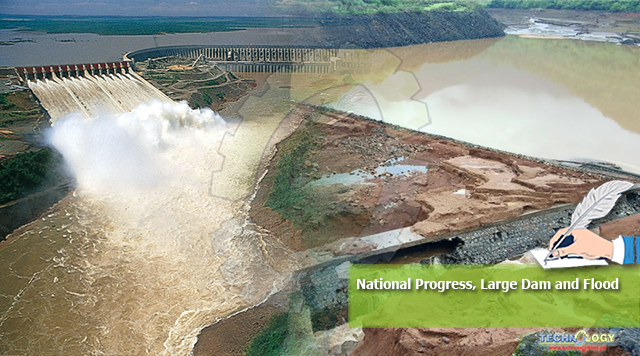Water is life and to save water is the one of the most important duty for mankind. Supply of sweet water is the need of hour not only for Pakistan but for the whole world. Large dam can play an important role for sweet water, agriculture, cheap energy supply and controlling of floods.

Major reservoirs serve three purposes viz irrigation water, electric energy and prevention of floods. Since 70s our hydel development has been dismal and the mega reservoir projects are virtually on hold since Tarbela Dam (1974).
The surface storage is now less than 10% of the average annual flows. An agrarian economy, Pakistan should have achieved at least twenty percept storage capacity.
India would soon achieve 35% of its annual surface flow. WAPDA has advised the Federal government to start large dams for cheap energy, water storage and agriculture. Water reservoirs are one of the lowest cost electric energy resources.
All emphasis is now on a solitary project, the Diamer Bhasha Dam (DBD) which is inaugurated by the PM few days back.
It seems to put Kala Bagh Dam (KBD) in cold storage and may be considered as forgotten. Delay in KBD construction is a staggering wastage of billions of US dollars in the last fifty years. Only KBD met the criteria for a quick and cheap replacement reservoir to offset the storage capacity lost.
The history of floods in Pakistan have shown that KBD would have complemented Tarbela Dam’s intrinsic flood attenuation and mitigation capabilities.
Pakistan can face serious water scarcity in coming years if no proper and effective policy is made to save water during monsoon and for flooded water
The construction of proposed Munda storage project on the Swat river would also have been helpful for flood control. The Munda-KBD conjunctive operation present a wonderful opportunity for inter-provincial cooperation.
The energy output of KBD could increase due to Munda Dam and flood attenuation is another major bonus. The proposed KBD site about 160 KM downstream of Attock with a live storage capacity of 6.1 MAF and maximum construction level 915 ft. will act (similar to turbella dam)) as a downstream flood mitigator.
The propensity and survival of the country depends on Dams. KBD is a quick and economic lifeline for Pakistan. It has a perfect location for both irrigation and energy production. Pakistan needs water for its agricultural and energy needs. Imported energy (oil & gas) is not sustainable substitution.
Annual increase of 12% is the surface storage for next 20 years and to achieve the desired Hydel :Thermal ratio of 70:30 from Hydro Reservoirs and Run-of-River Projects within next 15 years is the need of hour for our country on war footing basis without any further delay.
More reservoirs on the Indus need focus and this policy should be followed with wisdom and political consensus. The Sindh groundwater is generally brackish and is becoming unfit for human consumption especially in urban areas.
The nation will have to build several mega dams and to enhance hydraulic & energy output of these three dams.
Akhori Dam project is a proposed multipurpose located 60 KM west of Islamabad as part of water vision 2025 is a revolutionary idea. The dam will be able to store 8.6 billion cubic meters of water that is split filling the Tarbela reservoir during the monsoon season.
It will also host a 600 MW hydro power plant, expected is generate an estimated 2155 GWH/year. Flood mitigation would be possible, and it would supplement the tarbela reservoir and will fulfil agricultural irrigation needs for next twenty years.
Water and Electricity are economic backbone of Pakistan. For a sustainable future, WAPDA has to be made viable and independent for decisions and implementation of strategic policies on the subject.
Pakistan needs a think tank for its hydrologic analysis and this strategic think tank now becomes vital. It is high time to end tyranny and defeat small differences over construction of large dams to save country from floods and load shedding with unlimited resources in this great country.
We lose precious water during monsoon every year for last more than 50 years and billions of rupees are wasted due to non-availability of storage capacity of rain & flooded water every year & construction of dams is only Solution to save water.
Only those nations & societies will grow & develop with sufficient water resources for irrigation & agriculture, Production of cheap energy, supply of sweet & cleaning water to public at low cost. Pakistan has sufficient water in three months (July-September) & less water availability for remaining nine months during a year.
Present government showed commitment to make dams while enhancing storage capacity of water.
Pakistan can face serious water scarcity in coming years if no proper and effective policy is made to save water during monsoon and for flooded water.
Political leadership role is very important to create awareness & political consensus among political parties & general public. Water crises can be resolved by statesmanship & with vision only.
Forests departments of the provinces especially, Punjab, has proposed to construct more than 150 small dams, which can not only store precious water but also help in charging the underground water reservoirs.
Pakistan is today surviving as it had large underground water, which unfortunately, is depleting due to excessive usage. Balochistan is facing severe shortages of underground water, as governmental policy to provide subsidized electricity to tubewells in 80s and 90s.
It led large extractions of water and now millions of hectors of gardens have converted into desert. No one planned that underground reservoir needed to be refilled which regional small dams could do. Planning work and feasibility of small dams are ready, and it would take little time to start work.
While work on large dams may continue, government should urgently initiate work on small dams. This would be done by provinces and save rainy water from flowing to the Sea.
Originally published at Daily times